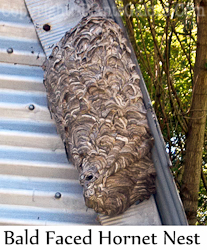 Unlike their more
socially inept cousins, the
solitary wasps,
social wasps live in colonies and share the feeding
and care of the young. The most common of these
critters are the yellow jackets, hornets and
umbrella or paper wasps. These insects build their
papery nests in abandoned rodent burrows or hanging
from trees or the side of structures. The nests are
made of plant fibers and the saliva of the wasp.
Unlike their more
socially inept cousins, the
solitary wasps,
social wasps live in colonies and share the feeding
and care of the young. The most common of these
critters are the yellow jackets, hornets and
umbrella or paper wasps. These insects build their
papery nests in abandoned rodent burrows or hanging
from trees or the side of structures. The nests are
made of plant fibers and the saliva of the wasp.
Depending on the
species, each nest may contain as few as 200 or as
many as 15,000 individuals. Unlike
honeybee
hives, these nests are abandoned in the fall and are
not reused the following spring. Instead, the goal
of the whole process is to produce a few queens who
will survive the winter and go out to start a new
nest the following year.
During the summer
season, many wasps will concentrate on protein
sources early in the year and then move toward sweet
things later. This is why they are attracted to your
hamburger in the early summer and to rotting fruit
later in the fall.
Social wasps tend to
be more aggressive than the solitary types when it
comes to defending their nests. Another way that
they differ from
honeybees is that wasps can sting
multiple times and not die.



